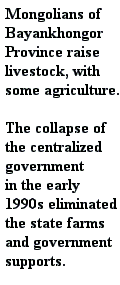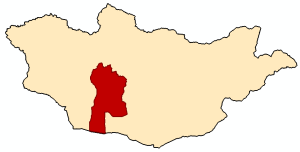 |
||||

|
The primary land use actions affecting ecosystem services and household well-being are mobility (frequency, distance and duration of moves), setting aside reserve pastures for the dormant season and emergency use, and decisions regarding herd size and composition. During and immediately prior to the initial study period (1994-1995), all of the key factors affecting household decision- making except ecology (economy, demography, infrastructure, land tenure, cooperating mechanisms) changed rapidly as a result of major political and economic transformations at the national level. Ecology has historically been the primary influence on herders? household land use decisions. In a system with few if any external inputs, herders move seasonally to match the nutritional and physiological demands of their animals with available forage and water resources, and to avoid or escape natural events such as drought or severe winter storms. Mobility is influenced by cooperative enabling mechanisms which provide labor, reciprocal pasture use rights and access to infrastructure?namely transportation for nomadic moves. Land tenure influences mobility by ensuring access to campsites and forage across a range of seasonal pasture areas. Lack of secure tenure leads herders to camp in one location for many seasons to protect rights to key resources or because they lack a suitable alternative campsite. Infrastructure influences mobility by determining herders? access to transportation and by constraining mobility when water developments are limiting. Similarly, loss of access to social service infrastructure (schools, hospitals, markets) discourages herders from moving far from population centers. Recent economic changes have led to increasing disparities in household well-being, and poorer households have less access to transportation and move less as a result. Demography has not been a major driver of land use decisions historically, since Mongolia is a sparsely populated nation. However, an increase in herding households immediately following livestock privatization in 1992 did affect pasture access, use of reserve pastures, and mobility to some extent.
Return to the map of sites.
| |||
 The Mongolia study sites are located at two extremes of a climatic and productivity gradient in
Bayankhongor Aimag (province) in west central Mongolia. Ecological and household data from
these sites were gathered in 1994-1995, with household data collected again in 1999 on the same
sample of households. Both sites are temperate grasslands with unimodal precipitation patterns,
warm wet summers and cold dry winters. The northern site, Bayan-Ovoo Sum, is situated in the
mountain-steppe ecological zone, which receives an average of 230 mm of precipitation per year
with a CV of 28% and typical annual production of 500-800 kg/ha. In this zone plant biomass,
cover, diversity, and species composition are affected strongly by livestock grazing and the system
can be characterized as an equilibrium rangeland. Jinst
Sum lies 100 km to the south in the Gobi desert-steppe ecological zone and experiences an average
of 99mm of precipitation per year with a CV of 47-50%. Typical annual production is 50-250 kg/ha.
Vegetation dynamics at this site are driven primarily by precipitation with historic grazing intensity
explaining little variation in plant biomass, species composition or diversity.
This ecosystem can be characterized as a non-equilibrium rangeland. Both
sites are prone to periodic severe winter climatic disasters (known as dzuud), which generally occur
at least once every 5-8 years and can result in density-independent livestock mortality of up to 20%
of the local herd. The majority of households in both locations own
livestock and derive their livelihoods primarily as pastoralists, moving at least four times a year.
Herd composition in Bayan-Ovoo includes a larger proportion of cattle and sheep, while Jinst herds
contain more goats and camels.
The Mongolia study sites are located at two extremes of a climatic and productivity gradient in
Bayankhongor Aimag (province) in west central Mongolia. Ecological and household data from
these sites were gathered in 1994-1995, with household data collected again in 1999 on the same
sample of households. Both sites are temperate grasslands with unimodal precipitation patterns,
warm wet summers and cold dry winters. The northern site, Bayan-Ovoo Sum, is situated in the
mountain-steppe ecological zone, which receives an average of 230 mm of precipitation per year
with a CV of 28% and typical annual production of 500-800 kg/ha. In this zone plant biomass,
cover, diversity, and species composition are affected strongly by livestock grazing and the system
can be characterized as an equilibrium rangeland. Jinst
Sum lies 100 km to the south in the Gobi desert-steppe ecological zone and experiences an average
of 99mm of precipitation per year with a CV of 47-50%. Typical annual production is 50-250 kg/ha.
Vegetation dynamics at this site are driven primarily by precipitation with historic grazing intensity
explaining little variation in plant biomass, species composition or diversity.
This ecosystem can be characterized as a non-equilibrium rangeland. Both
sites are prone to periodic severe winter climatic disasters (known as dzuud), which generally occur
at least once every 5-8 years and can result in density-independent livestock mortality of up to 20%
of the local herd. The majority of households in both locations own
livestock and derive their livelihoods primarily as pastoralists, moving at least four times a year.
Herd composition in Bayan-Ovoo includes a larger proportion of cattle and sheep, while Jinst herds
contain more goats and camels.

